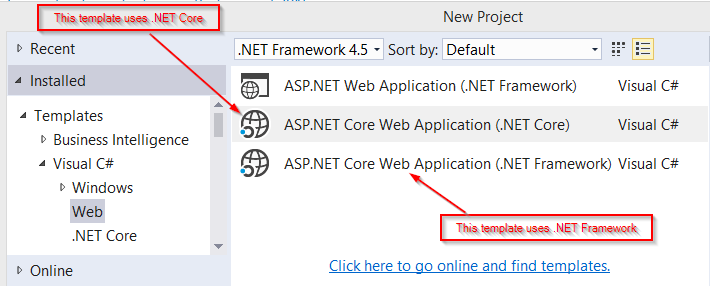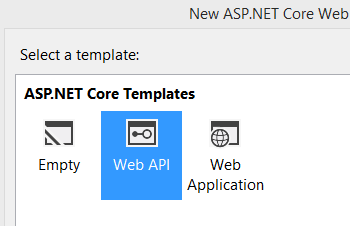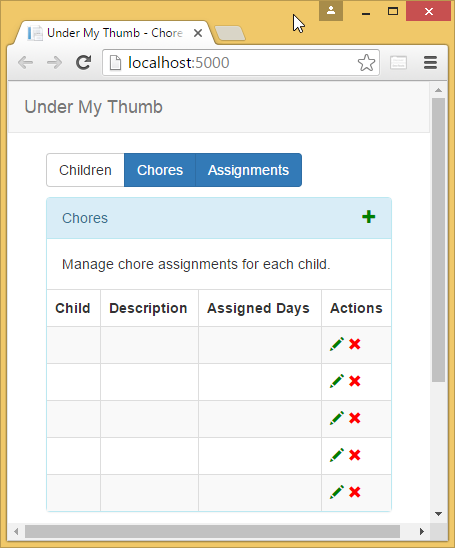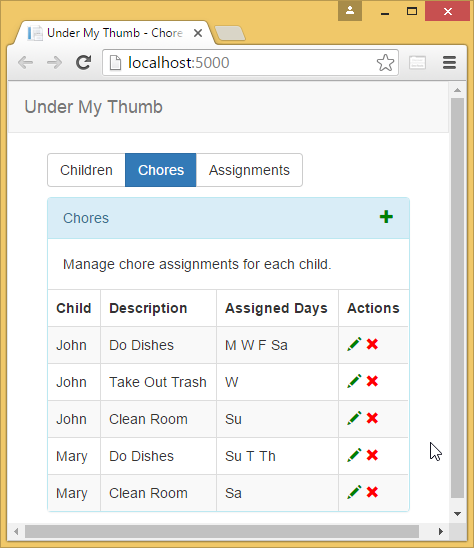Converting Web App to ASP.Net Core
September 2016
Follow along at:
http://itsnull.com/presentations/moveToCore/
Created by Kip Streithorst / @itsnull
Goal
- Have an simple existing web app (VS 2013 using WebAPI)
- Discuss why ASP.Net Core, .Net Core
- Convert to ASP.Net Core and .NET Core
- Demo converted app running on Linux
Starting App - DEMO
- Chore tracking application, built during previous set of meetups
- WebAPI v2, VS 2013
- No MVC, has static HTML
- No database
- Has custom in-memory persistence w/ optional write to disk
What is .Net Core?
- Cross platform, open-source .NET runtime
- Runs on Linux, Mac OS X and Windows, supported by MS
- Doesn't have to install globally, smaller footprint
- Can run isolated and multiple versions side by side
Why not .Net Core?
- Removed - App Domains, Remoting, Binary serialization, Sandboxing
- Gone, but might come back - System.Data.DataTable, System.Drawing, XSD, XSLT, System.Net.Mail
- Slight changes - Reflection
- As of today, most NuGet packages may not run on it. This should improve over time.
What is ASP.Net Core?
- Re-write of MVC and WebAPI
- Removes dependency on IIS and System.Web
- Merges WebAPI and MVC pipelines together, only one controller
- Higher performance in general, pay as you play performance model
- Runs on .NET Framework or .NET Core
Why not ASP.Net Core?
- Web.config gone - IIS provided that
- Manual conversion - MVC, WebAPI pipelines merged, new class names and namespaces.
- WebForms is not part of ASP.NET Core
- SignalR is missing in 1.0.0 release of ASP.Net Core
So, why again?
- More choices - choice of OS, choice of server
- Higher performance for ASP.Net Core
- Not at all tied to Visual Studio
- Smaller footprint, e.g. Docker containers
- Can be xcopy deployed, including .NET Core Runtime
- Still C#, still MVC, WebAPI pipeline with minor syntax changes
Convert to .NET Core?
- .NET Core might effect every dependency you have
- EF Core replaces EF, Azure .NET SDK - not working, Oracle DB Drivers - not working
- Use MS Portability Analyzer to check your code and dependencies
- Download console app (ApiPort): https://github.com/Microsoft/dotnet-apiport/releases
- How to use video: https://www.youtube.com/watch?v=Ox7qpsRq2LM
Convert to .NET Core? Maybe not
- ASP.Net Core will run on either .NET Core or .NET Framework
- My advice: port to ASP.Net Core first, then .NET Core
- Porting this way only affects one tier of your application
- For my presentation and web app, I'm porting both at the same time.
Converting to ASP.Net Core
- Use VS 2015 Update 3, update Microsoft ASP.Net and Web Tools extension
- File -> New project in VS 2015

- Decide between .NET Framework or .NET Core, you can change your mind later
Converting to ASP.Net Core
- Select WebAPI on the next screen for the template

- Demo template and discuss
- Demo in VS 2015, with IIS Express and console app
- Demo in VS Code
- Demo dotnet command-line
Converting to ASP.Net Core
- Copy C# code from WebAPI project into new project
- ApiController class gone, HttpResponseException class gone
- New controller base class, exception gone, routing and model binding changed
- Found WebApiCompatShim, part of ASP.Net Core
- Contains ApiController, HttpResponseException, original routing, etc...
Shim or Not?
- WebApiCompatShim makes transition much easier
- But new code is using a shim?
- Haven't researched a MVC shim or know if one is needed
- Decided to do 2 conversions: first with shim, second without shim
Enabling WebApiCompatShim
- Add nuget package to project.json
"dependencies": { "Microsoft.AspNetCore.Mvc.WebApiCompatShim": "1.0.0", } - Update Startup.cs, ConfigureServices method
public void ConfigureServices(IServiceCollection services) { //from this: services.AddMvc(); //to this: services.AddMvc().AddWebApiConventions(); }
Enabling WebApiCompatShim, Cont.
- Update Startup.cs, Configure
public void Configure(IApplicationBuilder app, IHostingEnvironment env, ILoggerFactory loggerFactory) { //from this: app.UseMvc(); //to this: app.UseMvc(options => options.MapWebApiRoute("DefaultApi", "api/{controller}/{id?}")); } - [Route] or [HttpGet], [HttpPost] attributes, moved to new namespace using Microsoft.AspNetCore.Mvc;
Compiling, but not MapPath
- This app has custom persistence, requires HostingEnvironment.MapPath("/App_Data/") to locate App_Data folder
- That class is part of System.Web, which ASP.Net core no longer uses.
- Replaced with IHostingEnvironment.ContentRootFileProvider. GetFileInfo("/App_Data").PhysicalPath
Fixing MapPath
- IHostingEnvironment is interface that my ChoreRepository needs
- So, ChoreRepository has to be configured to use ASP.Net Core Dependency Injection
- Update ChoreRepository constructor to take IHostingEnvironment parameter
- ChoreRepository previous had .GetInstance() method, convert all Controllers to receive ChoreRepository as constructor parameter
Fixing MapPath, Cont.
- Enlist ChoreRepository into DI system in Startup.cs
public void ConfigureServices(IServiceCollection services) { services.AddSingleton<ChoreRepository, ChoreRepository>(); }
Api works
- Success! Compiles and Runs!
- At this point, Api appears to work when tested manually
- Need static HTML and JS now
Add Static HTML, JS
- Content has to be in wwwroot/ folder
- Move css/, fonts/, images/, scripts/, index.html into wwwroot/ folder
- However, still doesn't work
Enable Static Serving
- Must enable static file serving
- Add nuget package to project.json
"dependencies": { "Microsoft.AspNetCore.StaticFiles": "1.0.0", }
Enable Static Serving, Cont.
- Update Startup.cs, Configure
public void Configure(IApplicationBuilder app, IHostingEnvironment env, ILoggerFactory loggerFactory) { app.UseStaticFiles(); } - http://localhost:5000/index.html works
- http://localhost:5000/ doesn't
Enable default routing
- Must enable default routing
- Update Startup.cs, Configure
public void Configure(IApplicationBuilder app, IHostingEnvironment env, ILoggerFactory loggerFactory) { app.UseDefaultFiles(); //must be before app.UseStaticFiles } - Now, http://localhost:5000/ works
Working???
- This probably doesn't count

JSON Serialization
- WebAPI would serialize a C# class to JSON with the exact same casing
- ASP.Net Core will serialize as JS case by default, so:
- class Person { string FirstName {get; set;} }
- Will serialize as "{firstName: ""}" with ASP.Net Core
- This is a breaking change
Fix JSON serialization
- So, either update all your JS code
- And any clients that use your api
- Or, have ASP.Net Core revert to prior behavior
Fix JSON serialization, Cont.
- Update Startup.cs, ConfigureServices method
public void ConfigureServices(IServiceCollection services) { //append AddJsonOptions to AddMvc() call services.AddMvc().AddJsonOptions(opt => { var res = opt.SerializerSettings.ContractResolver as DefaultContractResolver; if (res != null) { res.NamingStrategy = null; } }); }
It Works!

Model Binding Bug
- Two of my api calls don't work
- I get a 415 Unsupported Media Type response
- Why?
Model Binding Bug, Cont.
- Two ways to send complex data from client to server
//BODY: $.ajax({ type: 'POST', url: '/someUrl', contentType: 'application/json', data: JSON.stringify({ Name: 'Jane', Age: 2 }) }); //FORM: $.ajax({ type: 'POST', url: '/someUrl', data: { Name: 'Jane', Age: 2 } });
Model Binding Bug, Cont.
- WebAPI would check both form and body when model binding complex types
- ASP.Net Core will only check one of them
- Must use [FromBody] or [FromForm] attribute on method parameter
- In-depth blog post: http://andrewlock.net/model-binding-json-posts-in-asp-net-core/
Model Binding Bug, Cont.
- ASP.Net Core default if you don't do anything is assume you typed [FromForm]
- However, using WebApiCompatShim changes the default to [FromBody]
- Application JS that caused server error was submitting using Form, so I had to add [FromFrom] to that C# controller method
Demo on Linux
- Copy code over
- dotnet restore
- dotnet run
- http://localhost:5000/
Without the shim
- Remove WebApiCompatShim from project.json and Startup.cs
- Must add [FromBody] to controller methods that take complex types, e.g. POST, PUT
- Controller no longer has a subclass at all, previously ApiController
Without the shim, Cont.
- Add [Route("api/{controller}")] to each controller class
- Add [HttpGet()] to /api/controller/ methods
- Add [HttpGet("{id}")] to /api/controller/id/ methods
- Add [HttpPost()] to post methods, e.g. create
- Add [HttpPut("{id}")] to put methods, e.g. update
- Add [HttpDelete("{id}")] to delete methods
Without the shim, Cont.
- You might have to fix old [Route] attributes
- Previously, I had [Route("api/chores/complete")]
- But now that controller had [Route("api/{controller}"] added
- The two urls combined into /api/chores/api/chores/complete
- Updated existing attribute to [Route("complete")]
Without the shim, Cont.
- Had to fix usage of HttpResponseException
- Created three custom subclasses of Exception: DataConflictException, DataMissingException and InvalidRequestException
- Also switched to using built-in TimeoutException
- Had to write custom filter for ASP.Net Core pipeline
Without the shim, Cont.
- Converts exception into status code response
public override void OnException(ExceptionContext context) { var statusCode = HttpStatusCode.OK; if (context.Exception is DataConflictException) { statusCode = HttpStatusCode.Conflict; } else if (context.Exception is DataMissingException) { statusCode = HttpStatusCode.NotFound; } else if (context.Exception is InvalidRequestException) { statusCode = HttpStatusCode.BadRequest; } else if (context.Exception is TimeoutException) { statusCode = HttpStatusCode.RequestTimeout; } if (statusCode != HttpStatusCode.OK) { context.ExceptionHandled = true; context.Result = new StatusCodeResult((int)statusCode); } }
Without the shim, Cont.
- Must register custom filter into pipeline
- Update Startup.cs, ConfigureServices method
public void ConfigureServices(IServiceCollection services) { services.AddMvc(opt => { opt.Filters.Add(new DataExceptionFilterAttribute()); }); }
Demo on Linux
- Copy code over
- VS code works just as well
- code .
- Debug with VS code
- http://localhost:5000/
All code is available
- https://github.com/kstreith/ConvertingWebApiToAspNetCore
- OriginalWebApi/ folder runs in VS 2013
- ConvertedUsingShim/ folder runs in VS Code, dotnet command line, VS 2015 Update 3
- ConvertedFully/ folder
- Feel free to diff directories to see what was changed
Thanks, Any Questions?
- Kip Streithorst
- Sample Code: https://github.com/kstreith/ConvertingWebApiToAspNetCore
- Twitter: @itsnull
- Blog: http://itsnull.com/
- Presentation: http://itsnull.com/presentations/moveToCore/